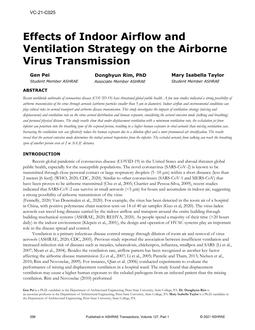Description
Recent worldwide outbreaks of coronavirus disease (COVID-19) have threatened global public health. A few new studies indicated a strong possibility of airborne transmission of the virus through aerosols (airborne particles smaller than 5 μm in diameter). Indoor airflow and environmental conditions can play critical roles in aerosol transport and airborne disease transmission. This study investigates the impacts of ventilation strategy (mixing and displacement) and ventilation rate on the virus aerosol distribution and human exposure, considering the aerosol emission mode (talking and breathing) and personal physical distance. The study results show that under displacement ventilation with a minimum ventilation rate, the exhalation jet from infector can penetrate into the breathing zone of the exposed person, resulting in a higher human exposure to viral aerosols than mixing ventilation case. Increasing the ventilation rate can effectively reduce the human exposure due to a dilution effect and a more pronounced air stratification. The results reveal that the aerosol emission mode determines the initial aerosol trajectories from the infector. The exhaled aerosols from talking can reach the breathing zone of another person even at 2 m [6.6 ft] distance.
Citation: 2021 Virtual Conference Papers
Product Details
- Published:
- 2021
- Number of Pages:
- 10
- Units of Measure:
- Dual
- File Size:
- 1 file , 2 MB
- Product Code(s):
- D-VC-21-C025




